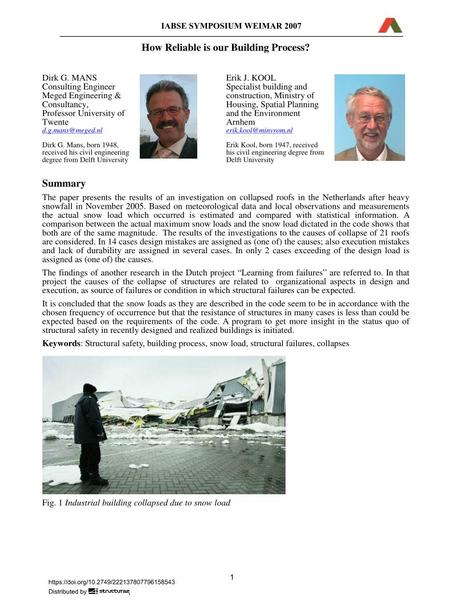How Reliable is our Building Process?

|
|
|||||||||||
Détails bibliographiques
| Auteur(s): |
Dirk G. Mans
Erik J. Kool |
||||
|---|---|---|---|---|---|
| Médium: | papier de conférence | ||||
| Langue(s): | anglais | ||||
| Conférence: | IABSE Symposium: Improving Infrastructure Worldwide, Weimar, Germany, 19-21 September 2007 | ||||
| Publié dans: | IABSE Symposium Weimar 2007 | ||||
|
|||||
| Page(s): | 424-425 | ||||
| Nombre total de pages (du PDF): | 8 | ||||
| Année: | 2007 | ||||
| DOI: | 10.2749/222137807796158543 | ||||
| Abstrait: |
The paper presents the results of an investigation on collapsed roofs in the Netherlands after heavy snowfall in November 2005. Based on meteorological data and local observations and measurements the actual snow load which occurred is estimated and compared with statistical information. A comparison between the actual maximum snow loads and the snow load dictated in the code shows that both are of the same magnitude. The results of the investigations to the causes of collapse of 21 roofs are considered. In 14 cases design mistakes are assigned as (one of) the causes; also execution mistakes and lack of durability are assigned in several cases. In only 2 cases exceeding of the design load is assigned as (one of) the causes. The findings of another research in the Dutch project “Learning from failures” are referred to. In that project the causes of the collapse of structures are related to organizational aspects in design and execution, as source of failures or condition in which structural failures can be expected. It is concluded that the snow loads as they are described in the code seem to be in accordance with the chosen frequency of occurrence but that the resistance of structures in many cases is less than could be expected based on the requirements of the code. A program to get more insight in the status quo of structural safety in recently designed and realized buildings is initiated. |
||||
